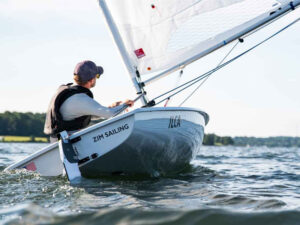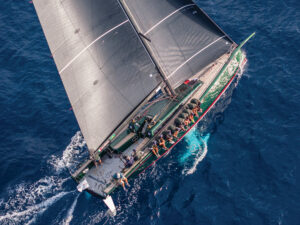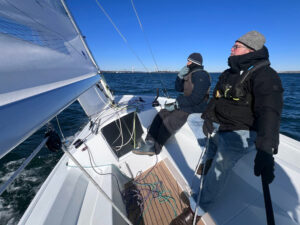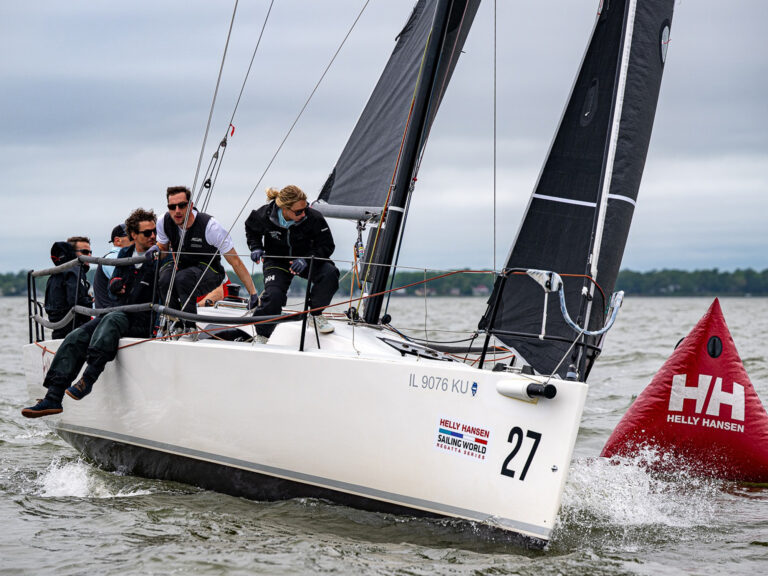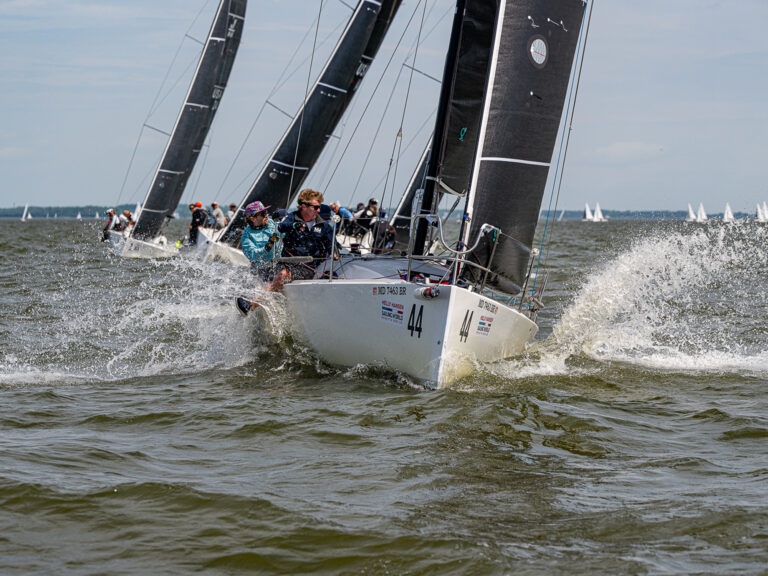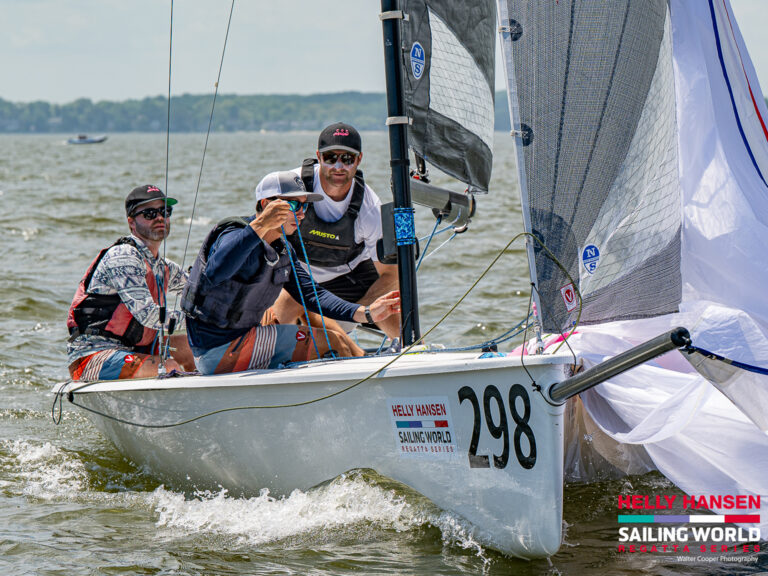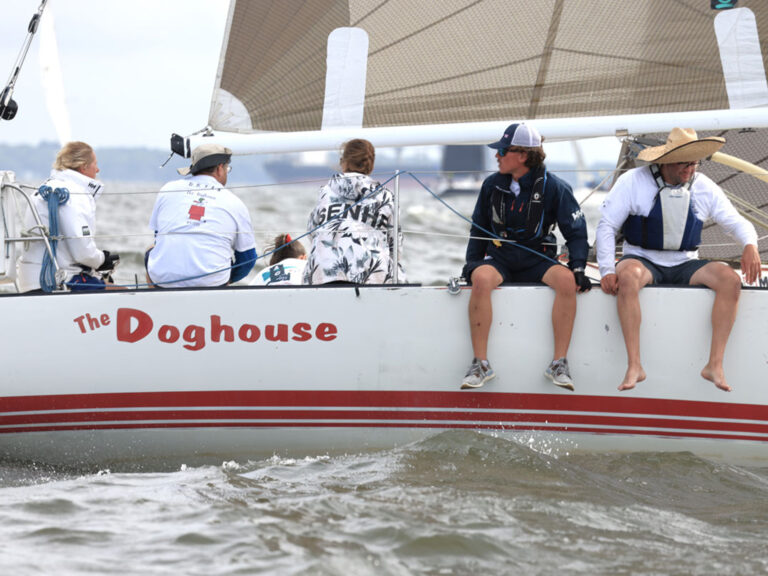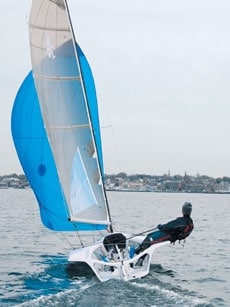
Bongo Review
Last summer, Paul Cronin, a naval architect from Jamestown, R.I., architect from Jamestown, R.I., teased our curiosity when we casually asked him what he’d been up to lately. “I’m working on a project that will revolutionize sailing,” he said with an ear-to-ear grin. We pressed for more, but Cronin was tight-lipped, adding that he would tell us more when his pet project was ready for prime time. “Trust me,”he added, “it’s very, very cool.” Three months later, before the East Coast’s fall boatshow circuit, Cronin rolled out to the public what he’d been tinkering with for the previous 18 months. Enter the Bongo, an ultralight 15-foot “sportboat for one.” Think combination Laser and Melges 24-two benchmark boats blended into one. He was right. It is very cool. After several knee surgeries, Cronin was finding it too painful to crouch in the shallow cockpit of his Laser on light-air days. When asked, his doctor laid out two options for him-replace his knees or hang up his Laser sail. The latter was obviously the more appealing choice, so he started designing a high-performance boat he could singlehand comfortably. “What Idid was come up with a boat that Iwould love to sail myself,”says Cronin, “and then from there, Ide-tuned it a bit to appeal to a broader audience.”The influence of Cronin’s International 14 sailing is obvious in the boat’s chined hull, high-aspect foils, and tapered carbon rig; and his Laser experience is evident in the simplicity of the systems. The boat, which is built for Cronin by Abbott Boats in Ontario, Canada, weighs only 350 pounds all up (that’s 30 pounds less than a Snipe), and the sail inventory includes a 112-sq. ft. full-batten North Sails Kevlar main and 147-sq. ft. Airex asymmetric spinnaker. Below the waterline is a 3’11” lifting carbon-reinforced keel with a 100-pound lead bulb. Beam at the waterline is 3′, but the wing tip-to-wing tip spread is 6’6″. We took a near-final prototype for a spin on a 5- to 8-knot day in November in Newport, and had a blast, hiking off the wings as the boat sailed effortlessly upwind and down. That was the easy part. The hard part was kicking our displacement-sailing habits and remembering to keep the bow down upwind and to sail higher angles downwind. With so little hull in the water, the boat moved lightly as the leeward chine grabbed hold and kept the boat tracking. Even though you’re sailing what feels like a 15-foot dinghy, you’re still dragging around a lump of lead, so the Bongo’s keelboat attributes are obvious. Upwind, the acceleration is gradual, and to keep pace you really have to pay attention to sail trim. But the stability from the keel is definitely there, and once you get things balanced, the boat practically sails itself-you could drop the tiller, lean in to tie your shoe, and never stray off course. Downwind, the Bongo’s performance is what you’d expect from a mini sportboat-cleat the main, trim the chute, slide aft, tuck your foot under the footstrap, lean back, and enjoy the ride. It’s that simple. The rig is ultra-sensitive to mainsheet trim, and the vang, led to cam cleats near the mainsheet block, is there to depower the rig, too. For gross depowering through the upper wind range, however, there’s a 2-to-1 one-line reefing system. Two reef points reduce the working mainsail area from 112 sq. ft. to 90, and then to 75 sq. ft. (roughly the sail area of a Laser). Cronin, an athletic 185-pounder, says he drops to the first reef in 20 knots. This is done by dropping the halyard to a preset mark and setting the reef line. To shake the reef, do the opposite. The spinnaker launch system is equally simple; a continuous halyard led to a cam cleat on the starboard side of the hardware console simultaneously extracts the 3’6″ sprit and hoists the kite. To douse, release the starboard halyard and take up the portside retrieval line. Four full-length pulls get it up and down. Abbott Boats is known for building winning Olympic-class Solings and Ynglings and the quality of the boat we sailed is on par. The hull is stiff because of a structural grid from bow to stern (cored panels glassed into the hull). CoreCell is used throughout the hull and deck, except in the hardware console. Both the swing-up rudder and the keel fin are a spruce/carbon/glass laminate. The carbon rig, which matches the full-battened sail beautifully, is built by Proctor UK and has an external mainsail track. The boom is a Proctor Aluminum D-shape section, and all hardware is from the Harken Carbo line. Because it’s primarily meant to be a singlehander, Cronin made sure he’s able to launch and retrieve the boat himself. The rig, which weighs only 15 pounds, is easy to step, and the keel is raised/lowered using a cockpit-mounted crane with a 7-to-1 purchase. A typical launch might go like this: step the mast, pin the lever forestay, rig lines, float the boat off the dolly or hoist, drop the keel, screw down the keel locking plates, store the crane in forward semi-watertight compartment, swing down the rudder, hoist the main, and go sailing. When you’re done having fun for the day, reverse procedure. You don’t need to always go sailing alone, though, and to this end there’s plenty of room for two in the boat, and Cronin foresees both single and doublehanded divisions as the Bongo spawns a one-design following. For $12,995, which includes boat, sails, hardware, and lines, the sportboat phenomenon can be yours and yours alone. Bongo LOA 15’2″ LWL 15′ Beam 6’6″ Draft 3’11” DSPL 350 lbs. SA (u/d) 112 sq. ft./259 sq. ft. Cost $12,995 www.sailabongo.com

